Related Research Articles

Sattriya, or Sattriya Nritya, is a major Indian classical dance. It was initially created as part of Bhaona which are performances of Ankiya Nat, one-act plays, originally created by Sankardev, a 15th-16th century polymath from Assam. These dances are part of the living traditions today of Sattra, which are communities of live-in devotees belonging to the Ekasarana Dharma, a Hindu sect established by Sankardev.

Darrang is an administrative district in the state of Assam in India. The district headquarters are located at Mangaldoi. The district occupies an area of 1585 km2.

Sonitpur district [Pron: ˌsə(ʊ)nɪtˈpʊə or ˌʃə(ʊ)nɪtˈpʊə] is an administrative district in the state of Assam in India. The district headquarters is located at Tezpur.
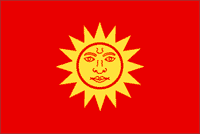
The Koch dynasty ruled parts of eastern Indian subcontinent in present-day Assam and Bengal. Biswa Singha established power in the erstwhile Kamata Kingdom which had emerged from the decaying Kamarupa Kingdom. The dynasty came to power by removing the Baro-Bhuyans, who had earlier removed the short-lived rule established by Alauddin Hussain Shah.

Koch Hajo (1581-1616) was the kingdom under Raghudev and his son Parikshit Narayan of the Koch dynasty that stretched from Sankosh river in the west to the Bhareli river in the east on the north bank of the Brahmaputra river. It was created by dividing the Kamata kingdom then under Nara Narayan in medieval Assam. The Sankosh river divided the two new kingdoms, and it is roughly the boundary between the present-day Assam and West Bengal. The western half of the Kamata kingdom emerged as Koch Bihar whereas the eastern half emerged as Koch Hajo. The name Hajo comes from the legendary king Hajo, a Koch tribal chief and an ancestor of the Koch dynasty, who ruled over the Rangpur division in present-day Bangladesh and some regions of present-day Assam.
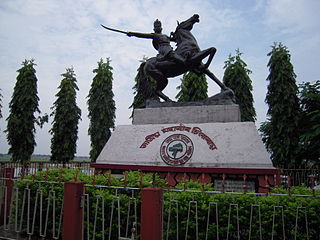
Sukladhwaja (1510-1577AD), was the 3rd son of Biswa Singha, founder of the Koch Dynasty in the Kamata Kingdom and younger brother of Nara Narayan, the 2nd king of the Koch dynasty of the Kamata kingdom in the 16th century. He was Nara Narayan's commander-in-chief and chief Minister (Dewan) of the kingdom. He got his name Chilarai because, as a general, he executed troop movements that were as fast as a chila (kite/Eagle).

Assamese cinema, is an Indian film industry of Assamese-language. It is based in Assam, India. The industry was born in 1935 when Jyoti Prasad Agarwala released his movie Joymoti. Since then the Assamese cinema has developed a slow-paced, sensitive style. In beginning the industry were called Jollywood, named for Agarwala's Jyoti Chitraban Film Studio.
Biju Phukan; 18 February 1947 – 22 November 2017) was an Assamese actor. He was born in Dibrugarh, India, where he studied in the Dibrugarh HS Kanoi College and Dibrugarh Govt boys' higher secondary school Dibrugarh. He appeared in more than eighty Assamese feature films. His first movie was Dr. Bezbarua (1970).
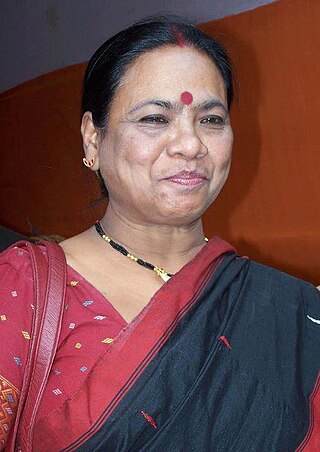
Chetana Das is an Indian actress from Assam. She is popular face in Assamese cinema for her comic roles. She is the comedy queen of Assamese film industry.
Jatin Bora is an Indian actor and director who has appeared in Assamese language films since 1989. He is also an actor and director in some mobile theatre groups of Assam, including Aabahan, Hengool, Ashirbaad, Bhagyadevi, Kohinoor, Itihas and Surjya.
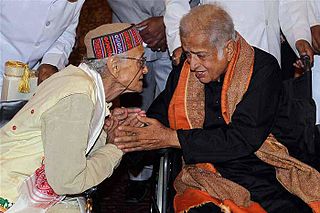
Mahim Bora was an Indian writer and educationist from Assam. He was elected as a president of the Assam Sahitya Sabha held in 1989 at Doomdooma. He was awarded most notably the Padma Shri in 2011, the Sahitya Akademi Award in 2001 and the Assam Valley Literary Award in 1998. Assam Sahitya Sabha conferred its highest honorary title Sahityacharyya on him in 2007.

Folk dances of Assam include the Bihu and the Bagurumba, the Bhortal, the Ojapali dance. Assam is home to many groups: Muslim, Indo-Aryan, Rabha, Bodo, Dimasa, Karbi, Mising, Sonowal Kacharis, Mishmi and Tiwa (Lalung) etc. These cultures come together to create an Assamese culture. Residents of the state of Assam are known as "Axomiya" (Assamese). Most tribes have their own language, although Assamese is the primary language of the state.

Jaya Seal is an Indian actress and dancer. She started learning Bharatanatyam from a very early age under Guru Indira P. P. Bora for five years. Simultaneously, she was also acting in Assamese television and did plays with noted Assamese theatre personalities from NSD like Dulal Roy and Baharul Islam who inspired her. She went to the National School of Drama in New Delhi where she subsequently completed her three-year course in 1997.
Beltola is a prime residential area in the southern part of Guwahati, Assam. It is an adjoining area of the Dispur capital complex. During Ahom reign, Beltola was a small Koch kingdom, whose ruler assisted in the administration of the Borphukan in Guwahati, the Ahom viceroy of Lower Assam and in maintaining relations with the communities of Khasi Hills. The kingdom of Beltola survived under the British rule and existed till 1947 when it finally joined the Union of India.
Kashmiri Saikia Baruah is an Indian film and stage actress and singers who works in Assamese cinema. She was born in Mangaldoi, Assam. She has played stellar roles in award-winning Assamese films such as Putola Ghar, Sandhya Raag, Agnisnaan and Hkhagoroloi Bohu Door.
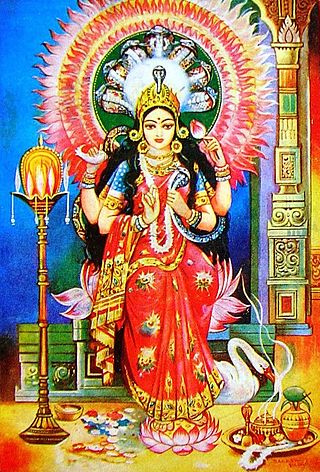
Ojapali is a traditional shamanistic type of indigenous folk dance from Assam in the northeastern region of India. Ojapali is believed to have evolved from Kathakata tradition and is performed in a group; it is believed to be one of the oldest art forms of Assam. Originally evolved in the Kamata state the western and northern part of river Brahmaputra later limited to Darrang area under the patronisation of Darrangi King Dharmanarayana. The repertoire of this performance consists of songs, dialogues, gesture, improvised acting and dramatisation etc. The group consists of an Oja, who leads the performance and four or five palies, who supplement the performance with continuously playing cymbal. Among the Palies Daina pali who stand on the right-hand side of the Oja is the active one and he and Oja take the performance forward. Many believe that Shankardev took inspiration from Ojapali to create his Ankiya Bhaona. Moreover he also created his own Sattriya Ojapali. Generally Darrangi Suknanni Ojapali sings the lyrics written by Sukabi Narayanadeva in Padmapurana. Padma Purana covers the story of serpent goddess Maroi(manasa devi). Ojapali is associated with Shakti Puja, including the deities manasa, kali, durga, kesikhaiti, kakogoshani etc.
Lalit Chandra Nath popularly known as Lalit Oja or Lalit Chandra Nath Oja was a notable person from Assam. He was born to a poor family in Saatghoriya Gaon, Sipajhar, Darrang district in 1923. His father Bhuban Chandra Nath was also an Sukananni Oja. Faguni Devi was his mother. He has been awarded the prestigious Sangeet Natak Akademi Award in 1983 and again in 2012 the same organization honoured him with the Rabindranath Tagore award for his expertise in Sukananni Ojapali and for contribution in popularizing this traditional folk art form. He has performed Ojapali and Deodhani dance in various places in and outside India.
Bhogeswar Baruah is an Indian former-athlete and coach. He was one of the first Assamese to win gold at an international event, winning a He gold medal in an 800-metre running event of at the 1966 Asian Games. He also won a silver medal in the 4 x 400 metres relay in the 1970 Asian games. He is a recipient of the Arjuna Award and is the first Assamese to obtain the Arjuna award.
Munin Barua was an Indian film director in Assamese cinematography. Among his best-known films are Pita-Putro, Prabhati Pokhir Gaan, Hiya Diya Niya, Daag, Nayak and Bidhata. Barua is widely regarded in Assam to have been one of the directors who helped popularize and establish Assamese cinema outside the state, primarily elsewhere in India where other industries had historically dominated. In 2000, his film Hiya Diya Niya became a first 'blockbuster hit' in Assamese cinema, which helped to revive the Assamese film industry. His another film, Dinabandhu received National Film Award for Best Feature Film in Assamese in 2005.
Atul Chandra Barua was the 46th president of Asam Sahitya Sabha and a prominent name in the modern Assamese literature. He was an ACS officer and an Assamese writer. He worked for the cause of Darrangi culture and was conferred with the title "Darrang Ratna".
References
Notes
- ↑ "The Telegraph - Calcutta : Northeast". www.telegraphindia.com. Archived from the original on 7 April 2005. Retrieved 30 April 2016.
- ↑ Sharma, Bobbeeta. "How Assamese film found its mojo". Scroll.in. Retrieved 30 April 2016.
- ↑ "Origin and Growth of Assamese Cinema" (PDF).
- ↑ "1st General body meeting of Consortium of Koch Royal Families (CONKORF) held". www.kamatapur.com. 28 September 2015. Retrieved 30 April 2016.
- ↑ "Softer side of a braveheart". The Telegraph. Archived from the original on 2 June 2016. Retrieved 30 April 2016.